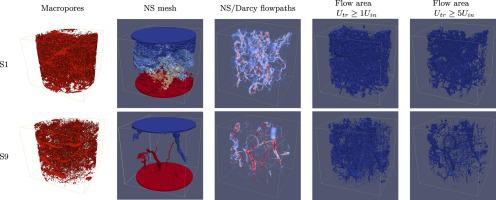Geoderma ( IF 6.1 ) Pub Date : 2021-09-22 , DOI: 10.1016/j.geoderma.2021.115467 Bartłomiej Gackiewicz , Krzysztof Lamorski , Mykola Kochiieru , Cezary Sławiński , Shao-Yiu Hsu , Liang-Cheng Chang

|
The saturated water flow phenomenon is determined by the soil pore transport processes occurring at a micro-scale. In this study, saturated water flow was modeled using two different approaches, depending on the existence of the percolating macropore network. The soil material comprised 26 undisturbed soil cores. Soil samples were scanned using an X-ray micro-CT scanner, and saturated hydraulic conductivity (Ksat), bulk density and particle size distribution were measured. The voxel size for X-ray CT scans of soil cores was 23.6 µm, which allowed soil macropore network discrimination. The macropore network was percolating in 11 samples, while the remaining cores were not. A typical approach based on Navier–Stokes (NS) equations was used for saturated water flow modeling in the case of a percolating samples. In the case of cores with a non-percolating macropore network, the NS modeling approach could not be used. An alternative method of modeling (NS/Darcy) was used in this case, blending: regular NS flow in the well-defined macropores with the Darcy–Forchheimer flow in the remaining part – the soil matrix. Soil matrix is treated by the NS/Darcy model as a pore medium without well-defined pore geometry but with some intrinsic permeability incorporated in the model using the Darcy–Forchheimer equation. Unlike the NS approach, the NS/Darcy model allowed for the simulation of water flow for all soil samples, including those where the macropore network was not percolating. Based on simulations, the Ksat was estimated used for model validation. The analysis of results leads to the proposal of a new hybrid modeling approach, mixing the NS and NS/Darcy modeling approaches. A good estimation of the Ksat was obtained using the proposed model (R2 = 0.61). The NS/Darcy modeling approach was used for the analysis of the macropore flow in the soil media. The simulations show that water permeates through the core, but macropores are a favorable flow path if they exist, even if they are not directly connected to each other. The areas of the soil cores taking part in the preferential, macropore flow were quantified, showing that only a small fraction of the macropores take part in water flow both for percolating and non-percolating cores. But generally, for most of the analyzed flow-related indices, apparent differences in results between percolating and non-percolating samples were observed. Effective flow area (EFA), i.e., the sample area used for water flow with a velocity higher than the threshold velocity (Utr) was analyzed. Considering the macropore flow, only ∼2% of sample volume is responsible for: 82% of the total flux in case of percolated and 34% in case of non-percolated samples. Also, for non-percolated samples, the dependence (R2 = 0.44) between relative flux participation and the effective flow area is observed. The simulation results for the non-percolating samples revealed the relationship between the simulated saturated conductivity of the whole soil sample and the saturated conductivity of the soil matrix and macroporosity. This allowed for developing a simple multiple linear regression model (R2 = 0.98) of the soil core’s hydraulic conductivity.
中文翻译:

渗透和非渗透大孔土壤介质中饱和水流的混合模拟
饱和水流现象是由发生在微观尺度上的土壤孔隙输运过程决定的。在这项研究中,根据渗透大孔网络的存在,使用两种不同的方法模拟饱和水流。土壤材料包括 26 个未受干扰的土壤核心。使用 X 射线显微 CT 扫描仪扫描土壤样品,并测量饱和导水率 (Ksat)、堆积密度和粒度分布。土壤核心的 X 射线 CT 扫描的体素大小为 23.6 µm,这允许土壤大孔网络区分。大孔网络在 11 个样品中渗透,而其余岩心则没有。在渗透样品的情况下,基于 Navier-Stokes (NS) 方程的典型方法用于饱和水流建模。在具有非渗透大孔网络的岩心的情况下,不能使用 NS 建模方法。在这种情况下,使用了另一种建模方法 (NS/Darcy),混合:定义明确的大孔隙中的规则 NS 流与剩余部分(土壤基质)中的 Darcy-Forchheimer 流。NS/Darcy 模型将土壤基质视为孔隙介质,没有明确定义的孔隙几何形状,但使用 Darcy-Forchheimer 方程在模型中加入了一些固有渗透率。与 NS 方法不同,NS/Darcy 模型允许模拟所有土壤样品的水流,包括那些大孔网络没有渗透的样品。基于模拟,估计 Ksat 用于模型验证。结果分析导致提出一种新的混合建模方法,混合 NS 和 NS/Darcy 建模方法。使用所提出的模型 (R2 = 0.61)。NS/Darcy 建模方法用于分析土壤介质中的大孔隙流动。模拟表明,水渗透到岩心,但如果存在大孔隙,即使它们没有直接相互连接,它们也是一个有利的流动路径。参与优先大孔隙流动的土壤核心区域被量化,表明只有一小部分大孔隙参与渗透和非渗透核心的水流。但一般来说,对于大多数分析的流动相关指数,观察到渗透和非渗透样品之间的结果存在明显差异。有效流动面积 (EFA),即用于流速高于阈值流速 (U tr) 进行了分析。考虑到大孔流动,只有约 2% 的样品体积负责:在渗滤情况下占总通量的 82%,在非渗滤样品情况下占总通量的 34%。此外,对于非渗透样品, 观察到相对通量参与和有效流动面积之间的相关性 (R 2 = 0.44)。非渗透样品的模拟结果揭示了整个土壤样品的模拟饱和电导率与土壤基质的饱和电导率和大孔隙度之间的关系。这允许开发 土壤核心水力传导率的简单多元线性回归模型 (R 2 = 0.98)。


























 京公网安备 11010802027423号
京公网安备 11010802027423号